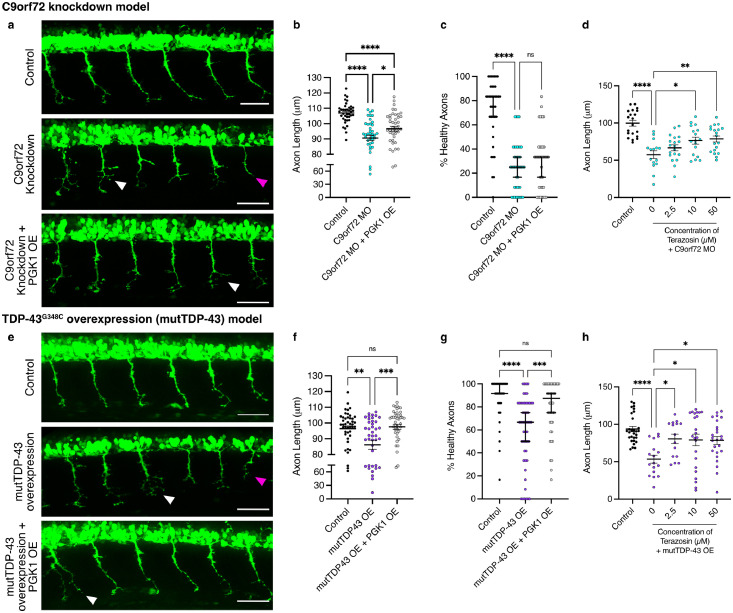Fig. 1
Targeting PGK1 genetically or pharmacologically improves motor axon phenotypes in zebrafish ALS models. (a) Representative fluorescent micrographs showing HB9:GFP+ve primary motor neuron outgrowth in uninjected controls, with morpholino-induced C9orf72 knockdown and with co-overexpression of PGK1. Knockdown of C9orf72 produces the motor axon phenotype of shorter axons (magenta arrows) and increased branching (white arrows). Scale bar=50 然 (b) C9orf72-knockdown (C9orf72 MO) decreases mean axon length and overexpression of PGK1 partially rescues this phenotype (one-way ANOVA P < 0.0001 with Tukey's multiple comparison test: Control vs C9orf72 MO P < 0.0001, C9orf72 MO vs C9orf72 MO + PGK1 OE P = 0.016; n = 39-45 per treatment group, n = 3 clutches). (c) Number of axons scored as ?healthy?, i.e. unbranched, in branching analysis. PGK1 overexpression does not change the branching phenotype in C9orf72 MO fish (Kruskal-Wallis P < 0.0001 with Dunn's multiple comparison test: Control vs C9orf72 MO P < 0.0001, C9orf72 MO vs C9orf72 MO + PGK1 OE P = 0.89; n = 39-45 per treatment group, n = 3 clutches). (d) C9orf72 MO larvae treated with increasing concentrations of terazosin. Terazosin significantly increases axon lengths at 10 然 and 50 然 (one-way ANOVA P < 0.0001 with Dunnett's multiple comparison test: Control vs C9orf72 MO P < 0.0001, C9orf72 MO vs 2.5 mM terazosin P = 0.40, C9orf72 MO vs 10 mM terazosin P = 0.02, C9orf72 MO vs 50 mM terazosin P = 0.005; n = 15-20 per treatment, n = 3 clutches). (e) Micrographs showing HB9:GFP+ve primary motor neuron outgrowth in uninjected controls, with mutant TDP-43G348C (mutTDP-43) overexpression and with co-overexpression of PGK1. Overexpression of mutTDP-43 produces the motor axon phenotype of shorter axons (magenta arrows) and increased branching (white arrows). Scale bar=50 然. (f) mutTDP-43 overexpression (OE) decreases mean axon length and overexpression of PGK1 rescues this phenotype (one-way ANOVA P = 0.0003 with Tukey's multiple comparison test: Control vs mutTDP43 OE P = 0.003, mutTDP43 OE vs mutTDP43 OE + PGK1 OE P = 0.0006, Control vs mutTDP43 OE + PGK1 OE P = 0.92; n = 44-51 per treatment, n = 3 clutches). (g) Number of axons scored as ?healthy?, i.e. unbranched, in branching analysis. PGK1 overexpression significantly increases the number of ?healthy? axons in the mutTDP-43 OE larvae (Kruskal-Wallis P < 0.0001 with Dunn's multiple comparison test: Control vs mutTDP43 OE P < 0.0001, mutTDP43 OE vs mutTDP43 OE + PGK1 OE P = 0.0006, Control vs mutTDP43 OE + PGK1 OE P = 0.13; n = 44-51 per treatment, n = 3 clutches). (h) mutTDP-43 OE larvae treated with increasing concentrations of terazosin. Terazosin significantly increases axon lengths at 2.5 mM, 10 然 and 50 然 (one-way ANOVA P = 0.0002 with Dunnett's multiple comparison test: Control vs mutTDP43 OE P < 0.0001, mutTDP43 OE vs 2.5 mM terazosin P = 0.017, mutTDP43 OE vs 10 mM terazosin P = 0.012, mutTDP43 OE vs 50 mM terazosin P = 0.0120; n = 15-29 per treatment, n = 3 clutches). Error bars represent s.e.m., ns=non-significant, * = P < 0.05, ** = P < 0.01, *** = P < 0.001, **** = P < 0.0001.

